NUR341 Assessment 2: Person-Centered Assessment and Care Analysis
VerifiedAdded on 2022/12/26
|19
|5245
|39
Report
AI Summary
This assignment presents a comprehensive patient assessment and care plan for Mr. Willie Jungala, a 71-year-old male admitted to the hospital following a fall. The report details the patient's history, including co-morbidities such as hypertension, type 2 diabetes, and unstable angina, as well as current medications and social history. The assessment covers vital signs, physical examination findings, and a review of systems. Part 1 of the assignment focuses on the rationale and purpose of various assessments, including alcohol withdrawal risk, cognitive function, falls risk, functional abilities, and nutritional status. Part 2 outlines nursing actions and referrals related to Mr. Jungala's impaired vision as a contributing factor to his fall. The assignment explores the implementation of nursing interventions and the importance of person-centered care. The final section will discuss a biopsychosocial approach to patient care, integrating biological, psychological, and social factors in the patient's treatment plan.
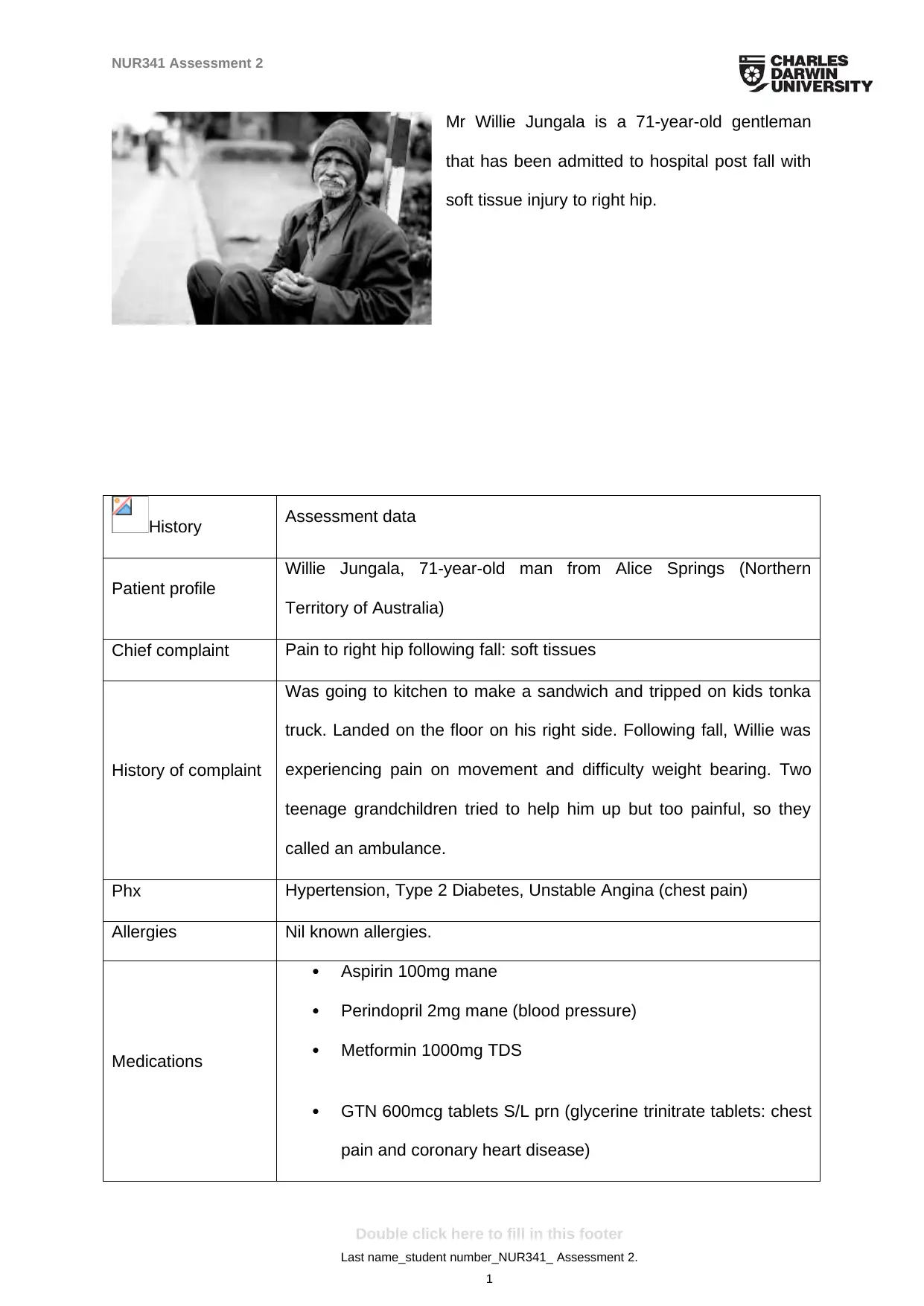
NUR341 Assessment 2
Mr Willie Jungala is a 71-year-old gentleman
that has been admitted to hospital post fall with
soft tissue injury to right hip.
History Assessment data
Patient profile
Willie Jungala, 71-year-old man from Alice Springs (Northern
Territory of Australia)
Chief complaint Pain to right hip following fall: soft tissues
History of complaint
Was going to kitchen to make a sandwich and tripped on kids tonka
truck. Landed on the floor on his right side. Following fall, Willie was
experiencing pain on movement and difficulty weight bearing. Two
teenage grandchildren tried to help him up but too painful, so they
called an ambulance.
Phx Hypertension, Type 2 Diabetes, Unstable Angina (chest pain)
Allergies Nil known allergies.
Medications
Aspirin 100mg mane
Perindopril 2mg mane (blood pressure)
Metformin 1000mg TDS
GTN 600mcg tablets S/L prn (glycerine trinitrate tablets: chest
pain and coronary heart disease)
Double click here to fill in this footer
Last name_student number_NUR341_ Assessment 2.
1
Mr Willie Jungala is a 71-year-old gentleman
that has been admitted to hospital post fall with
soft tissue injury to right hip.
History Assessment data
Patient profile
Willie Jungala, 71-year-old man from Alice Springs (Northern
Territory of Australia)
Chief complaint Pain to right hip following fall: soft tissues
History of complaint
Was going to kitchen to make a sandwich and tripped on kids tonka
truck. Landed on the floor on his right side. Following fall, Willie was
experiencing pain on movement and difficulty weight bearing. Two
teenage grandchildren tried to help him up but too painful, so they
called an ambulance.
Phx Hypertension, Type 2 Diabetes, Unstable Angina (chest pain)
Allergies Nil known allergies.
Medications
Aspirin 100mg mane
Perindopril 2mg mane (blood pressure)
Metformin 1000mg TDS
GTN 600mcg tablets S/L prn (glycerine trinitrate tablets: chest
pain and coronary heart disease)
Double click here to fill in this footer
Last name_student number_NUR341_ Assessment 2.
1
Paraphrase This Document
Need a fresh take? Get an instant paraphrase of this document with our AI Paraphraser
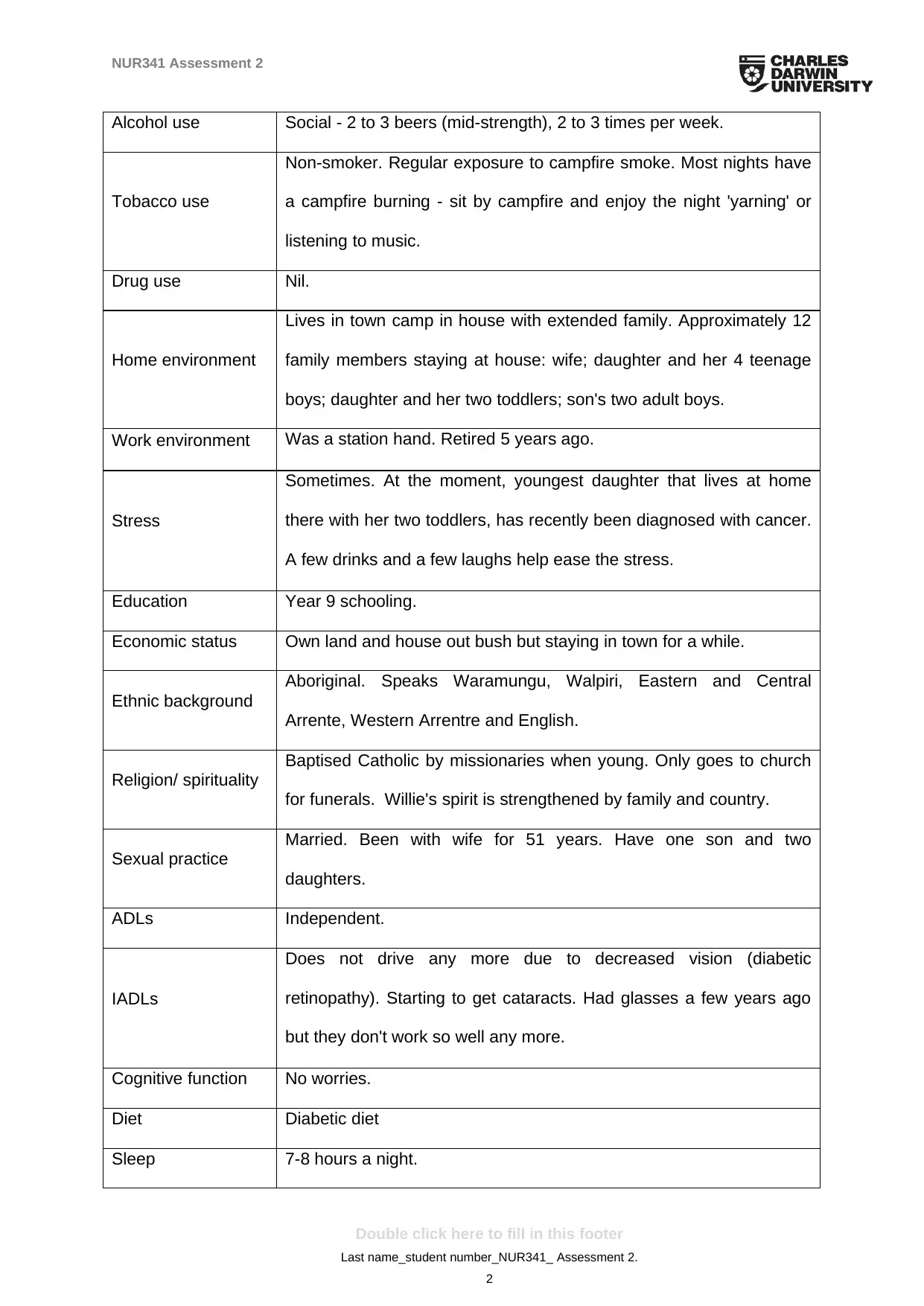
NUR341 Assessment 2
Alcohol use Social - 2 to 3 beers (mid-strength), 2 to 3 times per week.
Tobacco use
Non-smoker. Regular exposure to campfire smoke. Most nights have
a campfire burning - sit by campfire and enjoy the night 'yarning' or
listening to music.
Drug use Nil.
Home environment
Lives in town camp in house with extended family. Approximately 12
family members staying at house: wife; daughter and her 4 teenage
boys; daughter and her two toddlers; son's two adult boys.
Work environment Was a station hand. Retired 5 years ago.
Stress
Sometimes. At the moment, youngest daughter that lives at home
there with her two toddlers, has recently been diagnosed with cancer.
A few drinks and a few laughs help ease the stress.
Education Year 9 schooling.
Economic status Own land and house out bush but staying in town for a while.
Ethnic background
Aboriginal. Speaks Waramungu, Walpiri, Eastern and Central
Arrente, Western Arrentre and English.
Religion/ spirituality
Baptised Catholic by missionaries when young. Only goes to church
for funerals. Willie's spirit is strengthened by family and country.
Sexual practice
Married. Been with wife for 51 years. Have one son and two
daughters.
ADLs Independent.
IADLs
Does not drive any more due to decreased vision (diabetic
retinopathy). Starting to get cataracts. Had glasses a few years ago
but they don't work so well any more.
Cognitive function No worries.
Diet Diabetic diet
Sleep 7-8 hours a night.
Double click here to fill in this footer
Last name_student number_NUR341_ Assessment 2.
2
Alcohol use Social - 2 to 3 beers (mid-strength), 2 to 3 times per week.
Tobacco use
Non-smoker. Regular exposure to campfire smoke. Most nights have
a campfire burning - sit by campfire and enjoy the night 'yarning' or
listening to music.
Drug use Nil.
Home environment
Lives in town camp in house with extended family. Approximately 12
family members staying at house: wife; daughter and her 4 teenage
boys; daughter and her two toddlers; son's two adult boys.
Work environment Was a station hand. Retired 5 years ago.
Stress
Sometimes. At the moment, youngest daughter that lives at home
there with her two toddlers, has recently been diagnosed with cancer.
A few drinks and a few laughs help ease the stress.
Education Year 9 schooling.
Economic status Own land and house out bush but staying in town for a while.
Ethnic background
Aboriginal. Speaks Waramungu, Walpiri, Eastern and Central
Arrente, Western Arrentre and English.
Religion/ spirituality
Baptised Catholic by missionaries when young. Only goes to church
for funerals. Willie's spirit is strengthened by family and country.
Sexual practice
Married. Been with wife for 51 years. Have one son and two
daughters.
ADLs Independent.
IADLs
Does not drive any more due to decreased vision (diabetic
retinopathy). Starting to get cataracts. Had glasses a few years ago
but they don't work so well any more.
Cognitive function No worries.
Diet Diabetic diet
Sleep 7-8 hours a night.
Double click here to fill in this footer
Last name_student number_NUR341_ Assessment 2.
2
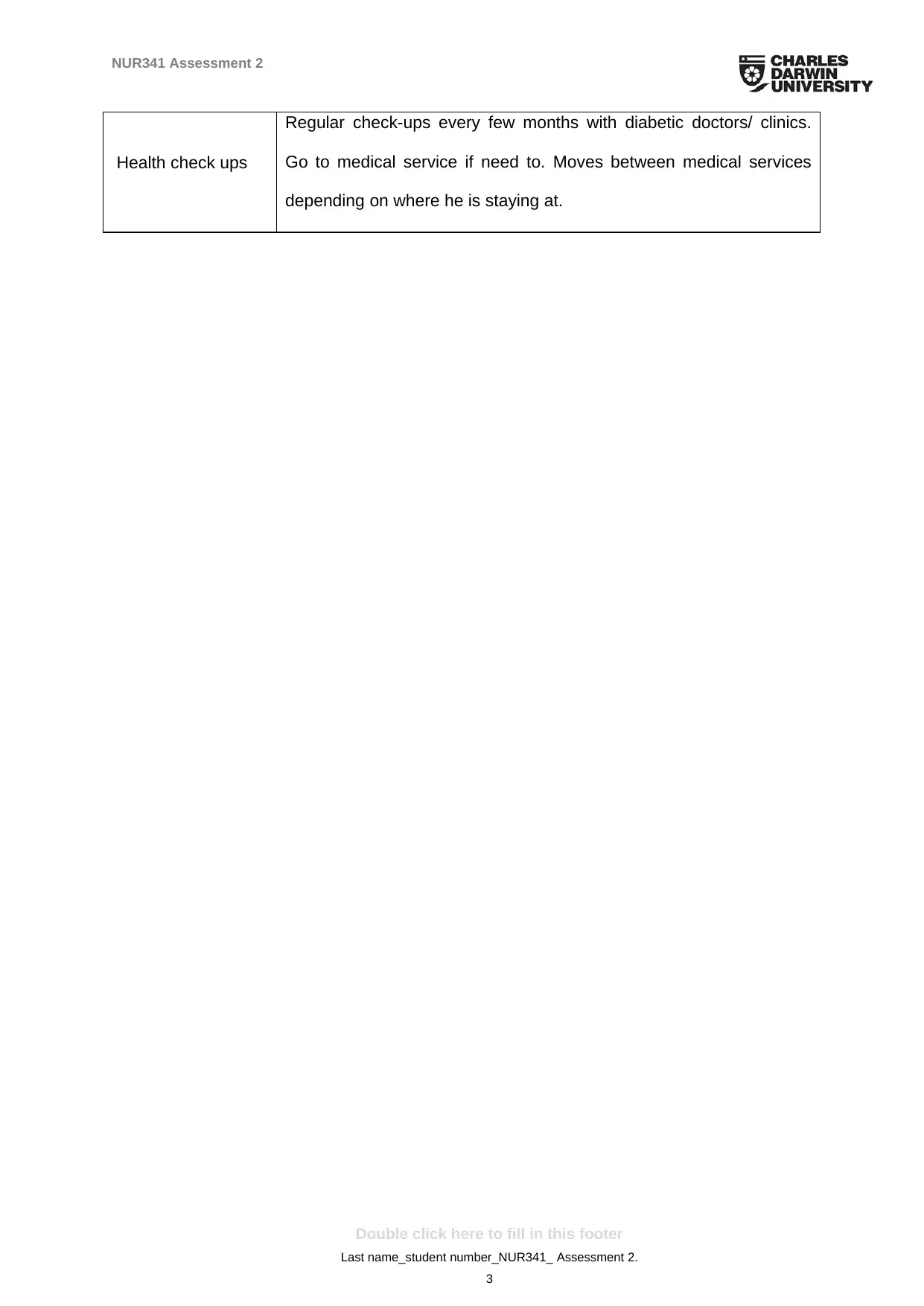
NUR341 Assessment 2
Health check ups
Regular check-ups every few months with diabetic doctors/ clinics.
Go to medical service if need to. Moves between medical services
depending on where he is staying at.
Double click here to fill in this footer
Last name_student number_NUR341_ Assessment 2.
3
Health check ups
Regular check-ups every few months with diabetic doctors/ clinics.
Go to medical service if need to. Moves between medical services
depending on where he is staying at.
Double click here to fill in this footer
Last name_student number_NUR341_ Assessment 2.
3
⊘ This is a preview!⊘
Do you want full access?
Subscribe today to unlock all pages.

Trusted by 1+ million students worldwide
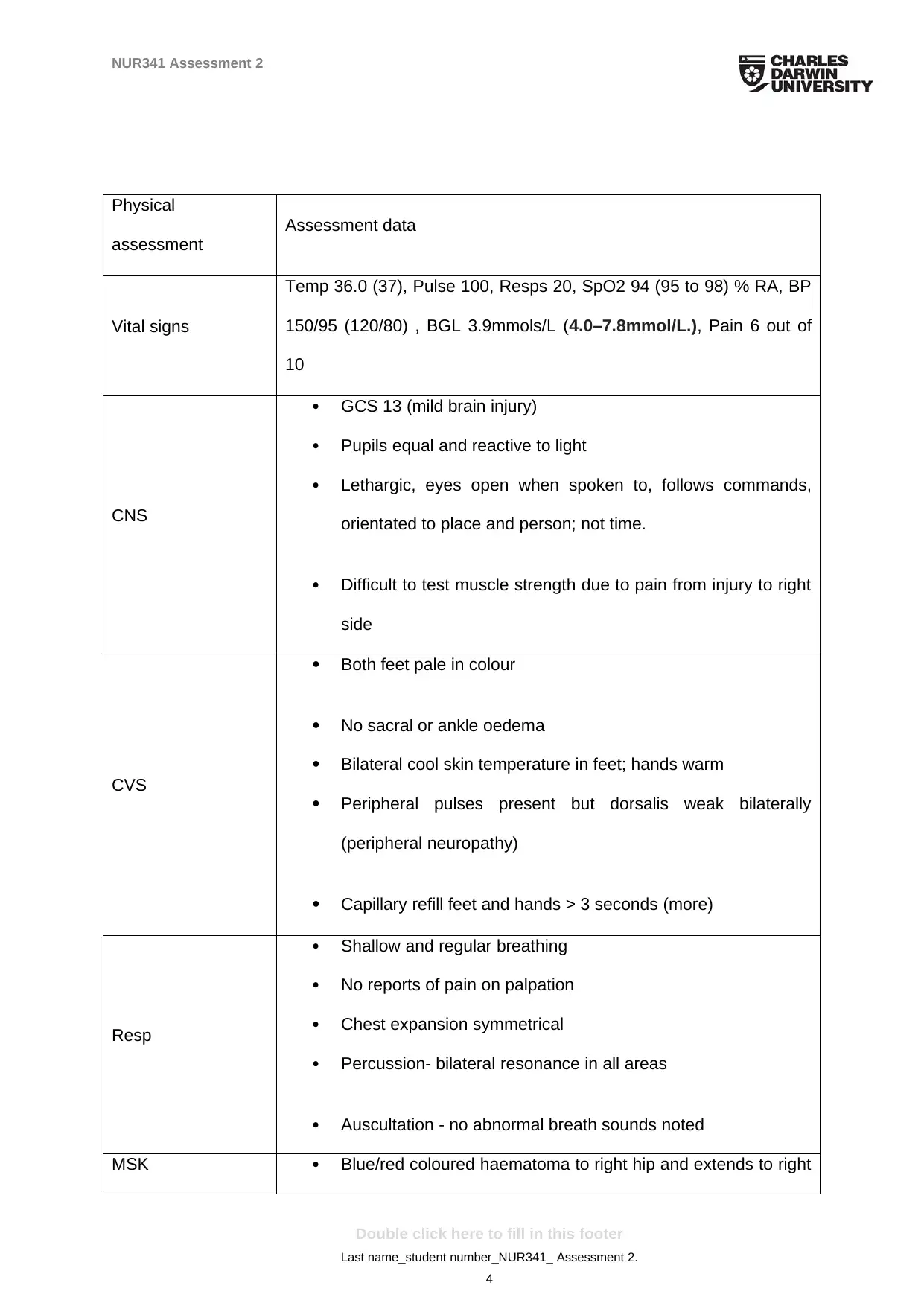
NUR341 Assessment 2
Physical
assessment
Assessment data
Vital signs
Temp 36.0 (37), Pulse 100, Resps 20, SpO2 94 (95 to 98) % RA, BP
150/95 (120/80) , BGL 3.9mmols/L (4.0–7.8mmol/L.), Pain 6 out of
10
CNS
GCS 13 (mild brain injury)
Pupils equal and reactive to light
Lethargic, eyes open when spoken to, follows commands,
orientated to place and person; not time.
Difficult to test muscle strength due to pain from injury to right
side
CVS
Both feet pale in colour
No sacral or ankle oedema
Bilateral cool skin temperature in feet; hands warm
Peripheral pulses present but dorsalis weak bilaterally
(peripheral neuropathy)
Capillary refill feet and hands > 3 seconds (more)
Resp
Shallow and regular breathing
No reports of pain on palpation
Chest expansion symmetrical
Percussion- bilateral resonance in all areas
Auscultation - no abnormal breath sounds noted
MSK Blue/red coloured haematoma to right hip and extends to right
Double click here to fill in this footer
Last name_student number_NUR341_ Assessment 2.
4
Physical
assessment
Assessment data
Vital signs
Temp 36.0 (37), Pulse 100, Resps 20, SpO2 94 (95 to 98) % RA, BP
150/95 (120/80) , BGL 3.9mmols/L (4.0–7.8mmol/L.), Pain 6 out of
10
CNS
GCS 13 (mild brain injury)
Pupils equal and reactive to light
Lethargic, eyes open when spoken to, follows commands,
orientated to place and person; not time.
Difficult to test muscle strength due to pain from injury to right
side
CVS
Both feet pale in colour
No sacral or ankle oedema
Bilateral cool skin temperature in feet; hands warm
Peripheral pulses present but dorsalis weak bilaterally
(peripheral neuropathy)
Capillary refill feet and hands > 3 seconds (more)
Resp
Shallow and regular breathing
No reports of pain on palpation
Chest expansion symmetrical
Percussion- bilateral resonance in all areas
Auscultation - no abnormal breath sounds noted
MSK Blue/red coloured haematoma to right hip and extends to right
Double click here to fill in this footer
Last name_student number_NUR341_ Assessment 2.
4
Paraphrase This Document
Need a fresh take? Get an instant paraphrase of this document with our AI Paraphraser
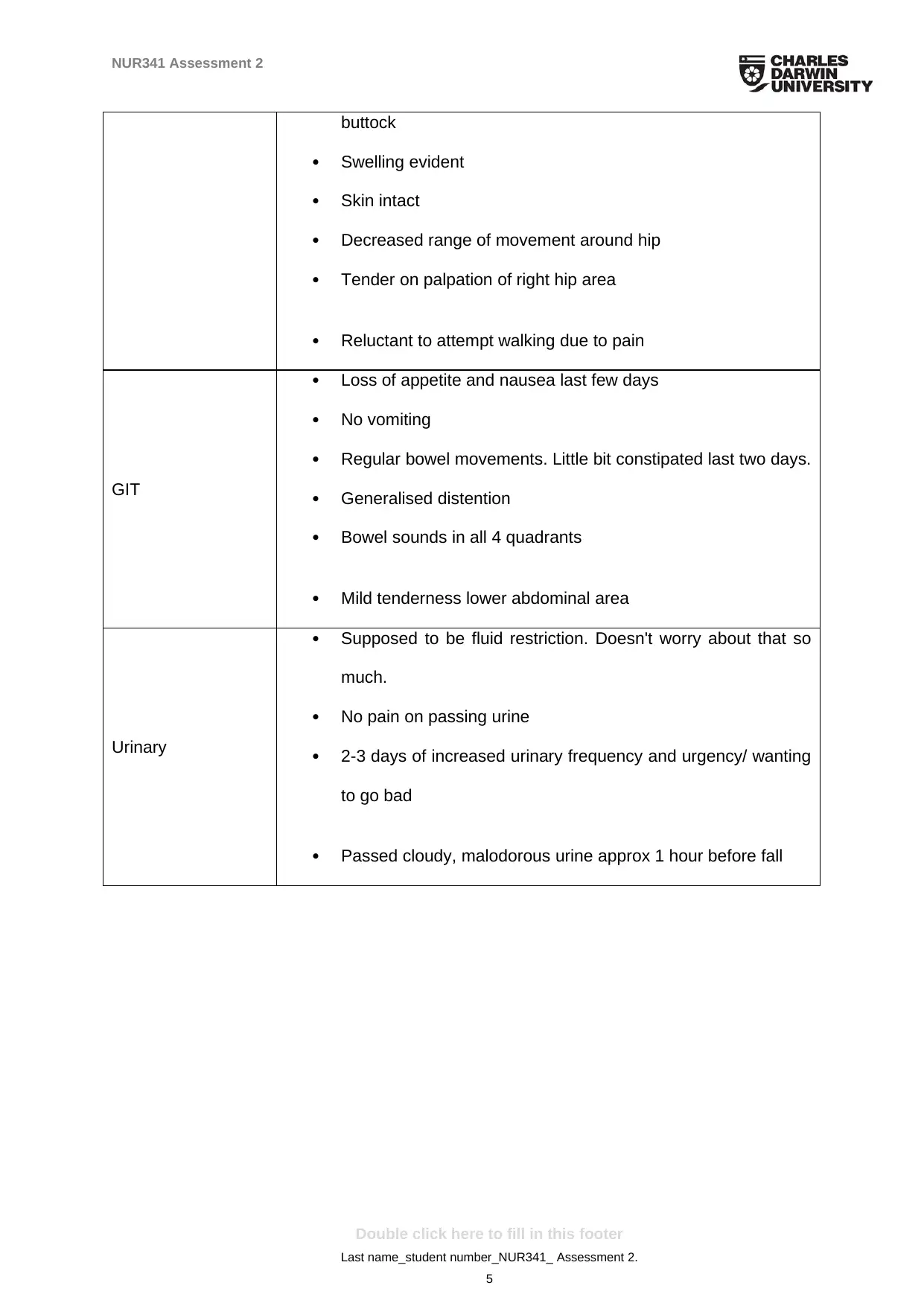
NUR341 Assessment 2
buttock
Swelling evident
Skin intact
Decreased range of movement around hip
Tender on palpation of right hip area
Reluctant to attempt walking due to pain
GIT
Loss of appetite and nausea last few days
No vomiting
Regular bowel movements. Little bit constipated last two days.
Generalised distention
Bowel sounds in all 4 quadrants
Mild tenderness lower abdominal area
Urinary
Supposed to be fluid restriction. Doesn't worry about that so
much.
No pain on passing urine
2-3 days of increased urinary frequency and urgency/ wanting
to go bad
Passed cloudy, malodorous urine approx 1 hour before fall
Double click here to fill in this footer
Last name_student number_NUR341_ Assessment 2.
5
buttock
Swelling evident
Skin intact
Decreased range of movement around hip
Tender on palpation of right hip area
Reluctant to attempt walking due to pain
GIT
Loss of appetite and nausea last few days
No vomiting
Regular bowel movements. Little bit constipated last two days.
Generalised distention
Bowel sounds in all 4 quadrants
Mild tenderness lower abdominal area
Urinary
Supposed to be fluid restriction. Doesn't worry about that so
much.
No pain on passing urine
2-3 days of increased urinary frequency and urgency/ wanting
to go bad
Passed cloudy, malodorous urine approx 1 hour before fall
Double click here to fill in this footer
Last name_student number_NUR341_ Assessment 2.
5
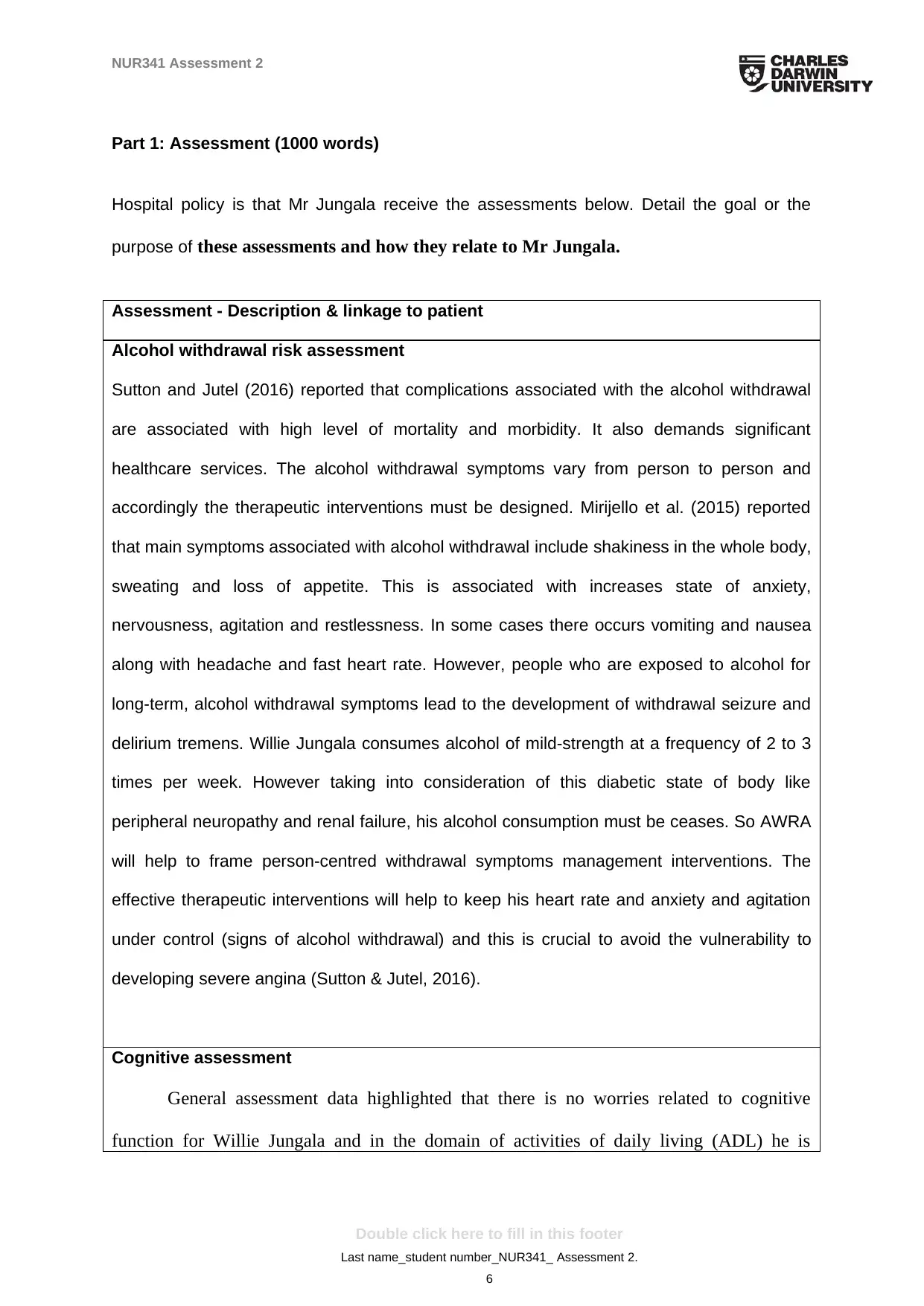
NUR341 Assessment 2
Part 1: Assessment (1000 words)
Hospital policy is that Mr Jungala receive the assessments below. Detail the goal or the
purpose of these assessments and how they relate to Mr Jungala.
Assessment - Description & linkage to patient
Alcohol withdrawal risk assessment
Sutton and Jutel (2016) reported that complications associated with the alcohol withdrawal
are associated with high level of mortality and morbidity. It also demands significant
healthcare services. The alcohol withdrawal symptoms vary from person to person and
accordingly the therapeutic interventions must be designed. Mirijello et al. (2015) reported
that main symptoms associated with alcohol withdrawal include shakiness in the whole body,
sweating and loss of appetite. This is associated with increases state of anxiety,
nervousness, agitation and restlessness. In some cases there occurs vomiting and nausea
along with headache and fast heart rate. However, people who are exposed to alcohol for
long-term, alcohol withdrawal symptoms lead to the development of withdrawal seizure and
delirium tremens. Willie Jungala consumes alcohol of mild-strength at a frequency of 2 to 3
times per week. However taking into consideration of this diabetic state of body like
peripheral neuropathy and renal failure, his alcohol consumption must be ceases. So AWRA
will help to frame person-centred withdrawal symptoms management interventions. The
effective therapeutic interventions will help to keep his heart rate and anxiety and agitation
under control (signs of alcohol withdrawal) and this is crucial to avoid the vulnerability to
developing severe angina (Sutton & Jutel, 2016).
Cognitive assessment
General assessment data highlighted that there is no worries related to cognitive
function for Willie Jungala and in the domain of activities of daily living (ADL) he is
Double click here to fill in this footer
Last name_student number_NUR341_ Assessment 2.
6
Part 1: Assessment (1000 words)
Hospital policy is that Mr Jungala receive the assessments below. Detail the goal or the
purpose of these assessments and how they relate to Mr Jungala.
Assessment - Description & linkage to patient
Alcohol withdrawal risk assessment
Sutton and Jutel (2016) reported that complications associated with the alcohol withdrawal
are associated with high level of mortality and morbidity. It also demands significant
healthcare services. The alcohol withdrawal symptoms vary from person to person and
accordingly the therapeutic interventions must be designed. Mirijello et al. (2015) reported
that main symptoms associated with alcohol withdrawal include shakiness in the whole body,
sweating and loss of appetite. This is associated with increases state of anxiety,
nervousness, agitation and restlessness. In some cases there occurs vomiting and nausea
along with headache and fast heart rate. However, people who are exposed to alcohol for
long-term, alcohol withdrawal symptoms lead to the development of withdrawal seizure and
delirium tremens. Willie Jungala consumes alcohol of mild-strength at a frequency of 2 to 3
times per week. However taking into consideration of this diabetic state of body like
peripheral neuropathy and renal failure, his alcohol consumption must be ceases. So AWRA
will help to frame person-centred withdrawal symptoms management interventions. The
effective therapeutic interventions will help to keep his heart rate and anxiety and agitation
under control (signs of alcohol withdrawal) and this is crucial to avoid the vulnerability to
developing severe angina (Sutton & Jutel, 2016).
Cognitive assessment
General assessment data highlighted that there is no worries related to cognitive
function for Willie Jungala and in the domain of activities of daily living (ADL) he is
Double click here to fill in this footer
Last name_student number_NUR341_ Assessment 2.
6
⊘ This is a preview!⊘
Do you want full access?
Subscribe today to unlock all pages.

Trusted by 1+ million students worldwide
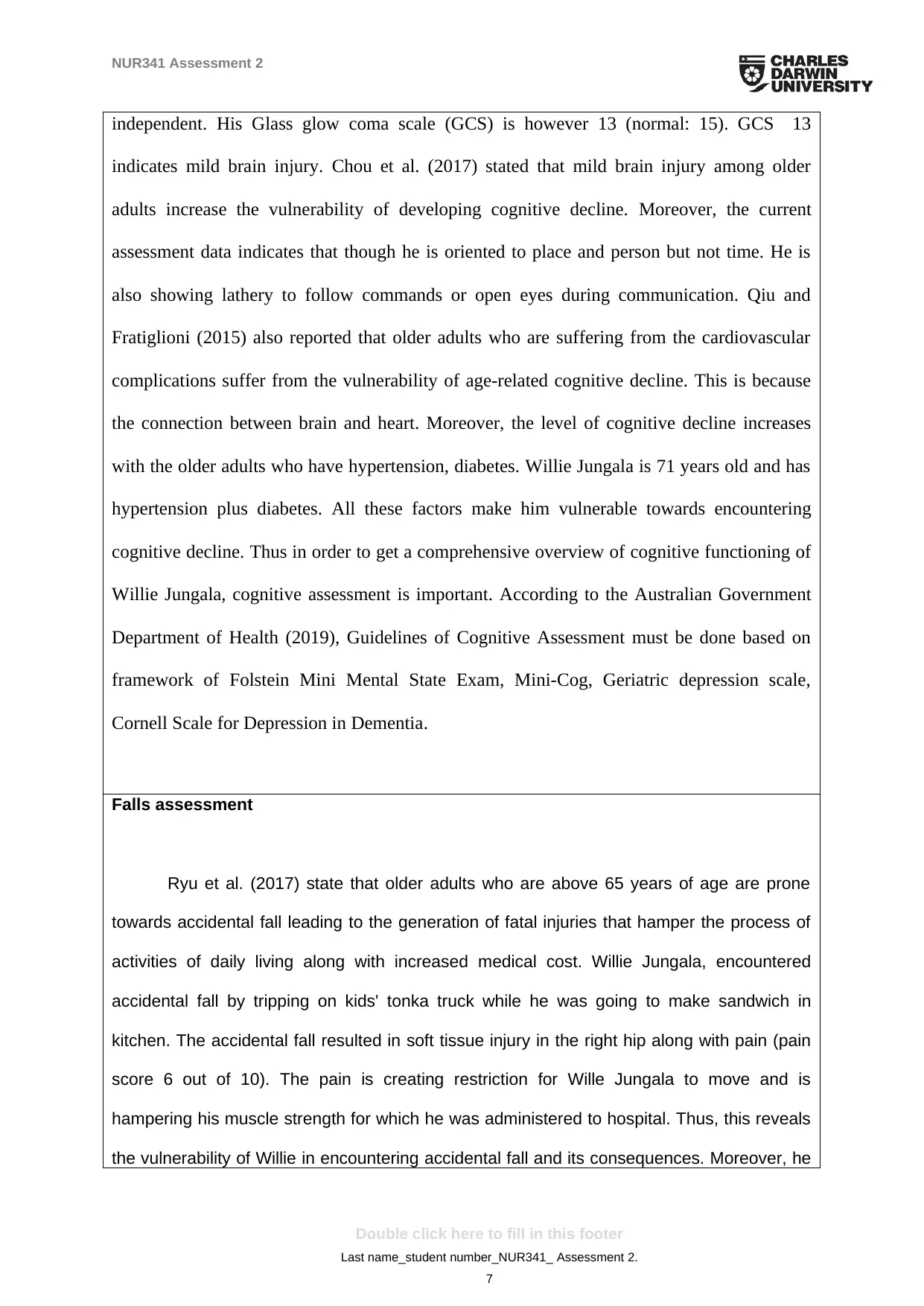
NUR341 Assessment 2
independent. His Glass glow coma scale (GCS) is however 13 (normal: 15). GCS 13
indicates mild brain injury. Chou et al. (2017) stated that mild brain injury among older
adults increase the vulnerability of developing cognitive decline. Moreover, the current
assessment data indicates that though he is oriented to place and person but not time. He is
also showing lathery to follow commands or open eyes during communication. Qiu and
Fratiglioni (2015) also reported that older adults who are suffering from the cardiovascular
complications suffer from the vulnerability of age-related cognitive decline. This is because
the connection between brain and heart. Moreover, the level of cognitive decline increases
with the older adults who have hypertension, diabetes. Willie Jungala is 71 years old and has
hypertension plus diabetes. All these factors make him vulnerable towards encountering
cognitive decline. Thus in order to get a comprehensive overview of cognitive functioning of
Willie Jungala, cognitive assessment is important. According to the Australian Government
Department of Health (2019), Guidelines of Cognitive Assessment must be done based on
framework of Folstein Mini Mental State Exam, Mini-Cog, Geriatric depression scale,
Cornell Scale for Depression in Dementia.
Falls assessment
Ryu et al. (2017) state that older adults who are above 65 years of age are prone
towards accidental fall leading to the generation of fatal injuries that hamper the process of
activities of daily living along with increased medical cost. Willie Jungala, encountered
accidental fall by tripping on kids' tonka truck while he was going to make sandwich in
kitchen. The accidental fall resulted in soft tissue injury in the right hip along with pain (pain
score 6 out of 10). The pain is creating restriction for Wille Jungala to move and is
hampering his muscle strength for which he was administered to hospital. Thus, this reveals
the vulnerability of Willie in encountering accidental fall and its consequences. Moreover, he
Double click here to fill in this footer
Last name_student number_NUR341_ Assessment 2.
7
independent. His Glass glow coma scale (GCS) is however 13 (normal: 15). GCS 13
indicates mild brain injury. Chou et al. (2017) stated that mild brain injury among older
adults increase the vulnerability of developing cognitive decline. Moreover, the current
assessment data indicates that though he is oriented to place and person but not time. He is
also showing lathery to follow commands or open eyes during communication. Qiu and
Fratiglioni (2015) also reported that older adults who are suffering from the cardiovascular
complications suffer from the vulnerability of age-related cognitive decline. This is because
the connection between brain and heart. Moreover, the level of cognitive decline increases
with the older adults who have hypertension, diabetes. Willie Jungala is 71 years old and has
hypertension plus diabetes. All these factors make him vulnerable towards encountering
cognitive decline. Thus in order to get a comprehensive overview of cognitive functioning of
Willie Jungala, cognitive assessment is important. According to the Australian Government
Department of Health (2019), Guidelines of Cognitive Assessment must be done based on
framework of Folstein Mini Mental State Exam, Mini-Cog, Geriatric depression scale,
Cornell Scale for Depression in Dementia.
Falls assessment
Ryu et al. (2017) state that older adults who are above 65 years of age are prone
towards accidental fall leading to the generation of fatal injuries that hamper the process of
activities of daily living along with increased medical cost. Willie Jungala, encountered
accidental fall by tripping on kids' tonka truck while he was going to make sandwich in
kitchen. The accidental fall resulted in soft tissue injury in the right hip along with pain (pain
score 6 out of 10). The pain is creating restriction for Wille Jungala to move and is
hampering his muscle strength for which he was administered to hospital. Thus, this reveals
the vulnerability of Willie in encountering accidental fall and its consequences. Moreover, he
Double click here to fill in this footer
Last name_student number_NUR341_ Assessment 2.
7
Paraphrase This Document
Need a fresh take? Get an instant paraphrase of this document with our AI Paraphraser
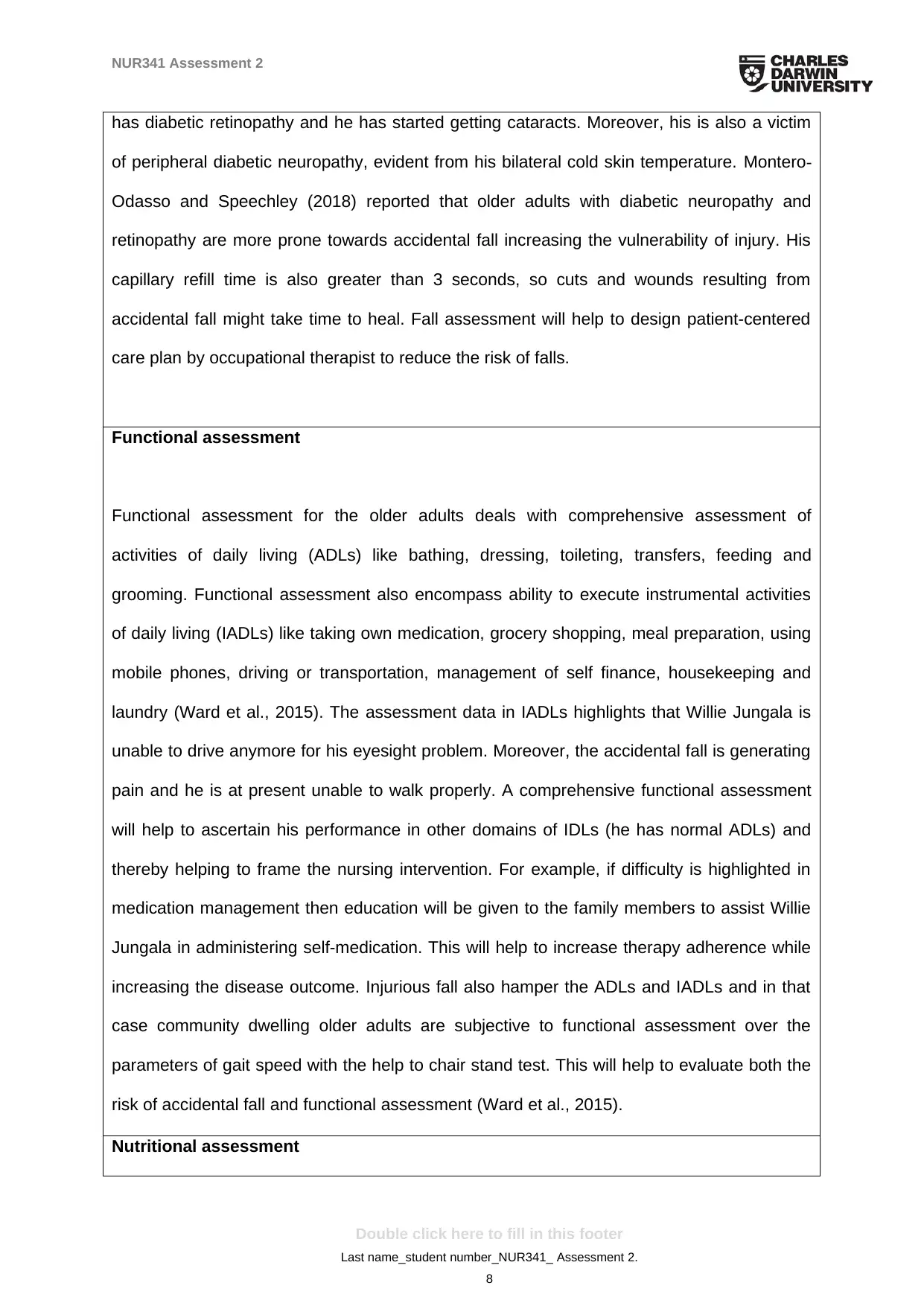
NUR341 Assessment 2
has diabetic retinopathy and he has started getting cataracts. Moreover, his is also a victim
of peripheral diabetic neuropathy, evident from his bilateral cold skin temperature. Montero‐
Odasso and Speechley (2018) reported that older adults with diabetic neuropathy and
retinopathy are more prone towards accidental fall increasing the vulnerability of injury. His
capillary refill time is also greater than 3 seconds, so cuts and wounds resulting from
accidental fall might take time to heal. Fall assessment will help to design patient-centered
care plan by occupational therapist to reduce the risk of falls.
Functional assessment
Functional assessment for the older adults deals with comprehensive assessment of
activities of daily living (ADLs) like bathing, dressing, toileting, transfers, feeding and
grooming. Functional assessment also encompass ability to execute instrumental activities
of daily living (IADLs) like taking own medication, grocery shopping, meal preparation, using
mobile phones, driving or transportation, management of self finance, housekeeping and
laundry (Ward et al., 2015). The assessment data in IADLs highlights that Willie Jungala is
unable to drive anymore for his eyesight problem. Moreover, the accidental fall is generating
pain and he is at present unable to walk properly. A comprehensive functional assessment
will help to ascertain his performance in other domains of IDLs (he has normal ADLs) and
thereby helping to frame the nursing intervention. For example, if difficulty is highlighted in
medication management then education will be given to the family members to assist Willie
Jungala in administering self-medication. This will help to increase therapy adherence while
increasing the disease outcome. Injurious fall also hamper the ADLs and IADLs and in that
case community dwelling older adults are subjective to functional assessment over the
parameters of gait speed with the help to chair stand test. This will help to evaluate both the
risk of accidental fall and functional assessment (Ward et al., 2015).
Nutritional assessment
Double click here to fill in this footer
Last name_student number_NUR341_ Assessment 2.
8
has diabetic retinopathy and he has started getting cataracts. Moreover, his is also a victim
of peripheral diabetic neuropathy, evident from his bilateral cold skin temperature. Montero‐
Odasso and Speechley (2018) reported that older adults with diabetic neuropathy and
retinopathy are more prone towards accidental fall increasing the vulnerability of injury. His
capillary refill time is also greater than 3 seconds, so cuts and wounds resulting from
accidental fall might take time to heal. Fall assessment will help to design patient-centered
care plan by occupational therapist to reduce the risk of falls.
Functional assessment
Functional assessment for the older adults deals with comprehensive assessment of
activities of daily living (ADLs) like bathing, dressing, toileting, transfers, feeding and
grooming. Functional assessment also encompass ability to execute instrumental activities
of daily living (IADLs) like taking own medication, grocery shopping, meal preparation, using
mobile phones, driving or transportation, management of self finance, housekeeping and
laundry (Ward et al., 2015). The assessment data in IADLs highlights that Willie Jungala is
unable to drive anymore for his eyesight problem. Moreover, the accidental fall is generating
pain and he is at present unable to walk properly. A comprehensive functional assessment
will help to ascertain his performance in other domains of IDLs (he has normal ADLs) and
thereby helping to frame the nursing intervention. For example, if difficulty is highlighted in
medication management then education will be given to the family members to assist Willie
Jungala in administering self-medication. This will help to increase therapy adherence while
increasing the disease outcome. Injurious fall also hamper the ADLs and IADLs and in that
case community dwelling older adults are subjective to functional assessment over the
parameters of gait speed with the help to chair stand test. This will help to evaluate both the
risk of accidental fall and functional assessment (Ward et al., 2015).
Nutritional assessment
Double click here to fill in this footer
Last name_student number_NUR341_ Assessment 2.
8
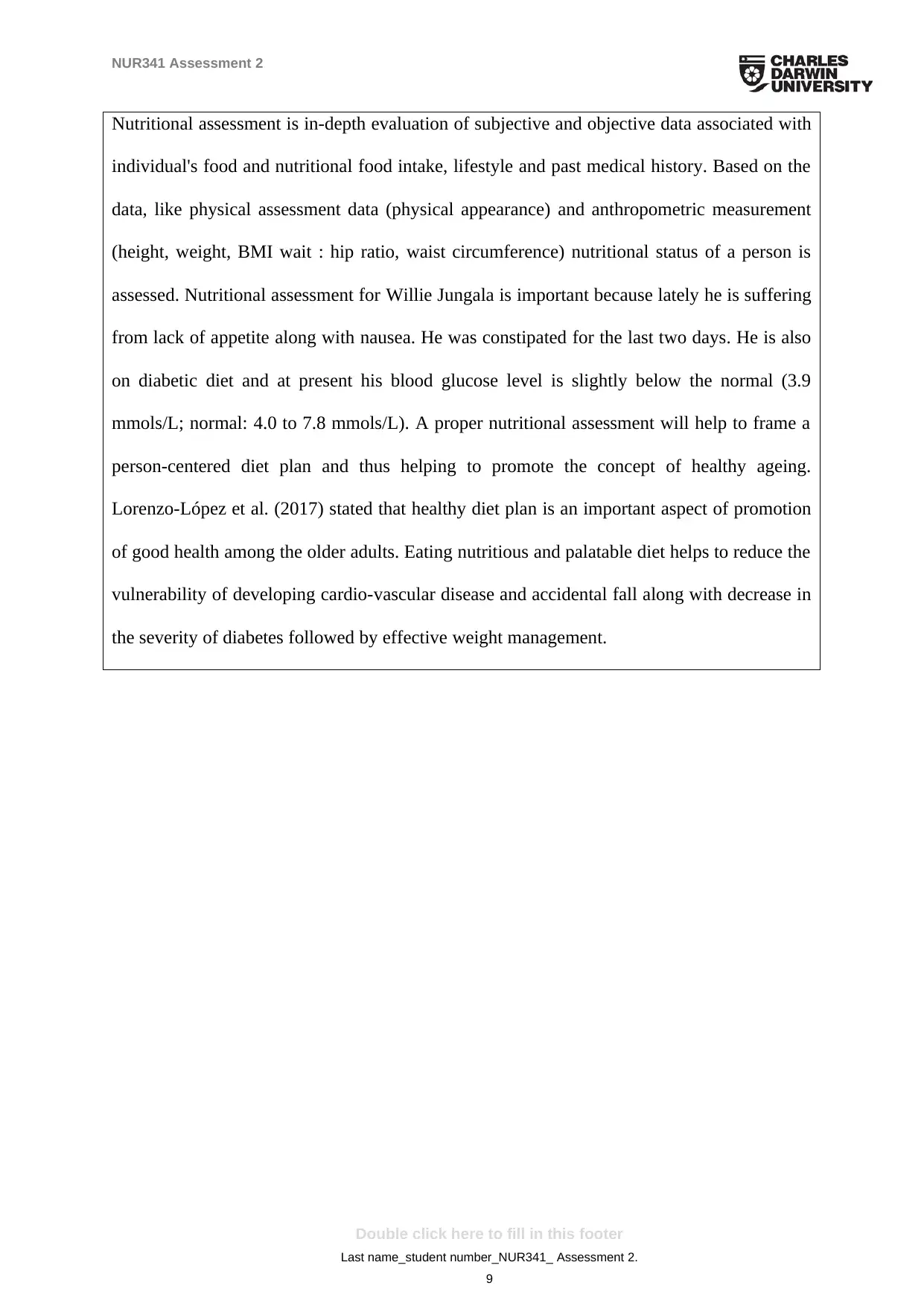
NUR341 Assessment 2
Nutritional assessment is in-depth evaluation of subjective and objective data associated with
individual's food and nutritional food intake, lifestyle and past medical history. Based on the
data, like physical assessment data (physical appearance) and anthropometric measurement
(height, weight, BMI wait : hip ratio, waist circumference) nutritional status of a person is
assessed. Nutritional assessment for Willie Jungala is important because lately he is suffering
from lack of appetite along with nausea. He was constipated for the last two days. He is also
on diabetic diet and at present his blood glucose level is slightly below the normal (3.9
mmols/L; normal: 4.0 to 7.8 mmols/L). A proper nutritional assessment will help to frame a
person-centered diet plan and thus helping to promote the concept of healthy ageing.
Lorenzo-López et al. (2017) stated that healthy diet plan is an important aspect of promotion
of good health among the older adults. Eating nutritious and palatable diet helps to reduce the
vulnerability of developing cardio-vascular disease and accidental fall along with decrease in
the severity of diabetes followed by effective weight management.
Double click here to fill in this footer
Last name_student number_NUR341_ Assessment 2.
9
Nutritional assessment is in-depth evaluation of subjective and objective data associated with
individual's food and nutritional food intake, lifestyle and past medical history. Based on the
data, like physical assessment data (physical appearance) and anthropometric measurement
(height, weight, BMI wait : hip ratio, waist circumference) nutritional status of a person is
assessed. Nutritional assessment for Willie Jungala is important because lately he is suffering
from lack of appetite along with nausea. He was constipated for the last two days. He is also
on diabetic diet and at present his blood glucose level is slightly below the normal (3.9
mmols/L; normal: 4.0 to 7.8 mmols/L). A proper nutritional assessment will help to frame a
person-centered diet plan and thus helping to promote the concept of healthy ageing.
Lorenzo-López et al. (2017) stated that healthy diet plan is an important aspect of promotion
of good health among the older adults. Eating nutritious and palatable diet helps to reduce the
vulnerability of developing cardio-vascular disease and accidental fall along with decrease in
the severity of diabetes followed by effective weight management.
Double click here to fill in this footer
Last name_student number_NUR341_ Assessment 2.
9
⊘ This is a preview!⊘
Do you want full access?
Subscribe today to unlock all pages.

Trusted by 1+ million students worldwide
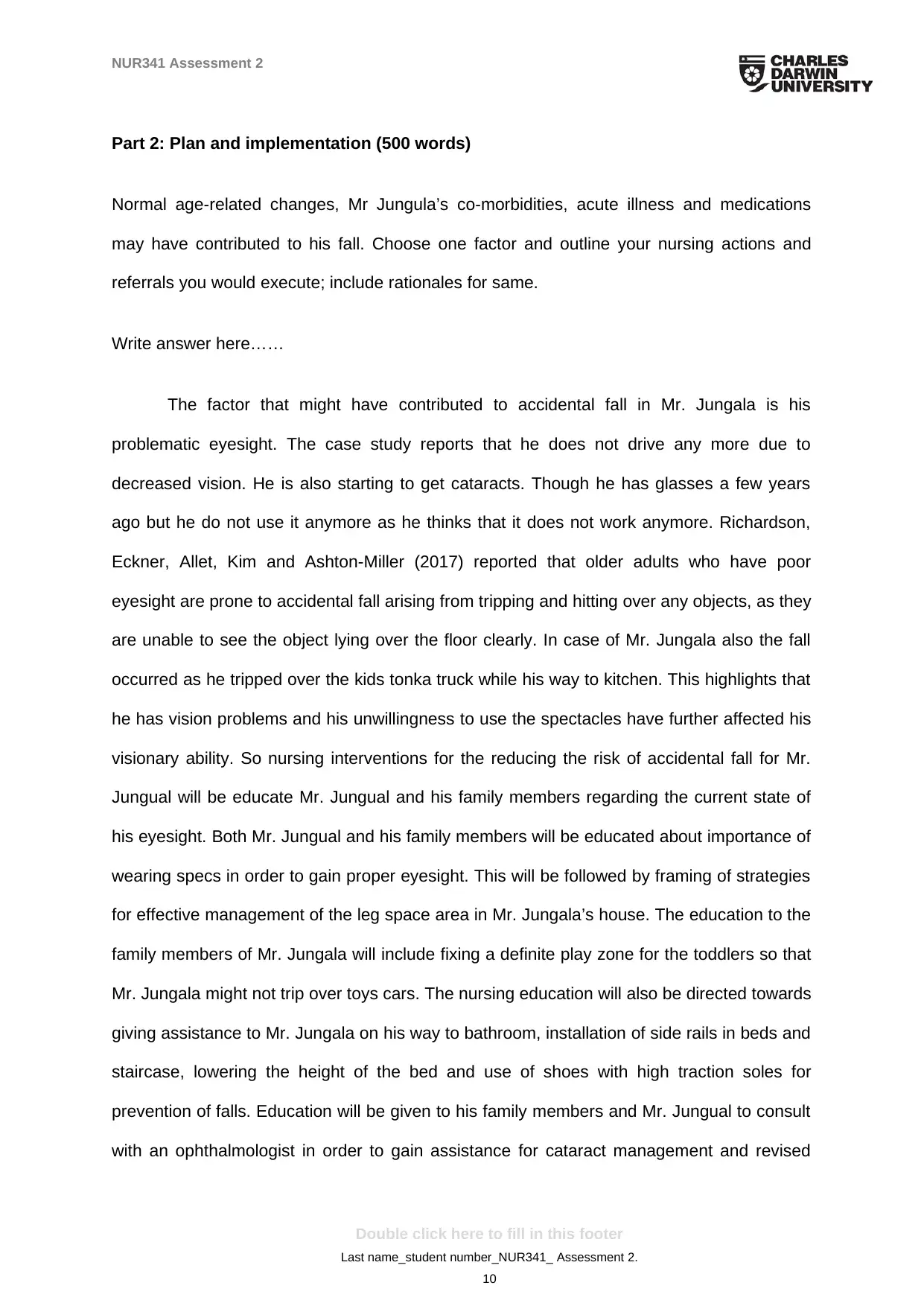
NUR341 Assessment 2
Part 2: Plan and implementation (500 words)
Normal age-related changes, Mr Jungula’s co-morbidities, acute illness and medications
may have contributed to his fall. Choose one factor and outline your nursing actions and
referrals you would execute; include rationales for same.
Write answer here……
The factor that might have contributed to accidental fall in Mr. Jungala is his
problematic eyesight. The case study reports that he does not drive any more due to
decreased vision. He is also starting to get cataracts. Though he has glasses a few years
ago but he do not use it anymore as he thinks that it does not work anymore. Richardson,
Eckner, Allet, Kim and Ashton-Miller (2017) reported that older adults who have poor
eyesight are prone to accidental fall arising from tripping and hitting over any objects, as they
are unable to see the object lying over the floor clearly. In case of Mr. Jungala also the fall
occurred as he tripped over the kids tonka truck while his way to kitchen. This highlights that
he has vision problems and his unwillingness to use the spectacles have further affected his
visionary ability. So nursing interventions for the reducing the risk of accidental fall for Mr.
Jungual will be educate Mr. Jungual and his family members regarding the current state of
his eyesight. Both Mr. Jungual and his family members will be educated about importance of
wearing specs in order to gain proper eyesight. This will be followed by framing of strategies
for effective management of the leg space area in Mr. Jungala’s house. The education to the
family members of Mr. Jungala will include fixing a definite play zone for the toddlers so that
Mr. Jungala might not trip over toys cars. The nursing education will also be directed towards
giving assistance to Mr. Jungala on his way to bathroom, installation of side rails in beds and
staircase, lowering the height of the bed and use of shoes with high traction soles for
prevention of falls. Education will be given to his family members and Mr. Jungual to consult
with an ophthalmologist in order to gain assistance for cataract management and revised
Double click here to fill in this footer
Last name_student number_NUR341_ Assessment 2.
10
Part 2: Plan and implementation (500 words)
Normal age-related changes, Mr Jungula’s co-morbidities, acute illness and medications
may have contributed to his fall. Choose one factor and outline your nursing actions and
referrals you would execute; include rationales for same.
Write answer here……
The factor that might have contributed to accidental fall in Mr. Jungala is his
problematic eyesight. The case study reports that he does not drive any more due to
decreased vision. He is also starting to get cataracts. Though he has glasses a few years
ago but he do not use it anymore as he thinks that it does not work anymore. Richardson,
Eckner, Allet, Kim and Ashton-Miller (2017) reported that older adults who have poor
eyesight are prone to accidental fall arising from tripping and hitting over any objects, as they
are unable to see the object lying over the floor clearly. In case of Mr. Jungala also the fall
occurred as he tripped over the kids tonka truck while his way to kitchen. This highlights that
he has vision problems and his unwillingness to use the spectacles have further affected his
visionary ability. So nursing interventions for the reducing the risk of accidental fall for Mr.
Jungual will be educate Mr. Jungual and his family members regarding the current state of
his eyesight. Both Mr. Jungual and his family members will be educated about importance of
wearing specs in order to gain proper eyesight. This will be followed by framing of strategies
for effective management of the leg space area in Mr. Jungala’s house. The education to the
family members of Mr. Jungala will include fixing a definite play zone for the toddlers so that
Mr. Jungala might not trip over toys cars. The nursing education will also be directed towards
giving assistance to Mr. Jungala on his way to bathroom, installation of side rails in beds and
staircase, lowering the height of the bed and use of shoes with high traction soles for
prevention of falls. Education will be given to his family members and Mr. Jungual to consult
with an ophthalmologist in order to gain assistance for cataract management and revised
Double click here to fill in this footer
Last name_student number_NUR341_ Assessment 2.
10
Paraphrase This Document
Need a fresh take? Get an instant paraphrase of this document with our AI Paraphraser
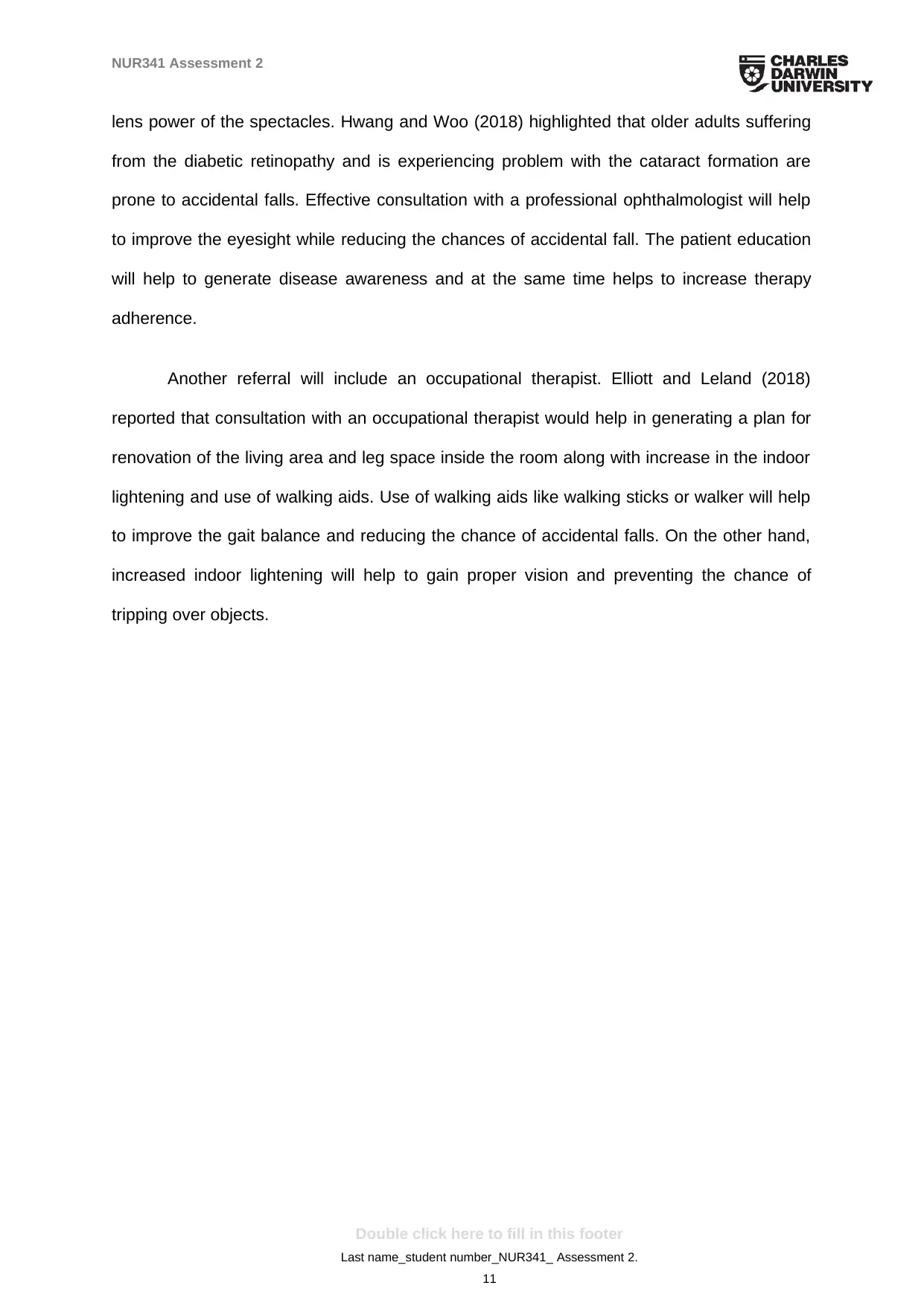
NUR341 Assessment 2
lens power of the spectacles. Hwang and Woo (2018) highlighted that older adults suffering
from the diabetic retinopathy and is experiencing problem with the cataract formation are
prone to accidental falls. Effective consultation with a professional ophthalmologist will help
to improve the eyesight while reducing the chances of accidental fall. The patient education
will help to generate disease awareness and at the same time helps to increase therapy
adherence.
Another referral will include an occupational therapist. Elliott and Leland (2018)
reported that consultation with an occupational therapist would help in generating a plan for
renovation of the living area and leg space inside the room along with increase in the indoor
lightening and use of walking aids. Use of walking aids like walking sticks or walker will help
to improve the gait balance and reducing the chance of accidental falls. On the other hand,
increased indoor lightening will help to gain proper vision and preventing the chance of
tripping over objects.
Double click here to fill in this footer
Last name_student number_NUR341_ Assessment 2.
11
lens power of the spectacles. Hwang and Woo (2018) highlighted that older adults suffering
from the diabetic retinopathy and is experiencing problem with the cataract formation are
prone to accidental falls. Effective consultation with a professional ophthalmologist will help
to improve the eyesight while reducing the chances of accidental fall. The patient education
will help to generate disease awareness and at the same time helps to increase therapy
adherence.
Another referral will include an occupational therapist. Elliott and Leland (2018)
reported that consultation with an occupational therapist would help in generating a plan for
renovation of the living area and leg space inside the room along with increase in the indoor
lightening and use of walking aids. Use of walking aids like walking sticks or walker will help
to improve the gait balance and reducing the chance of accidental falls. On the other hand,
increased indoor lightening will help to gain proper vision and preventing the chance of
tripping over objects.
Double click here to fill in this footer
Last name_student number_NUR341_ Assessment 2.
11
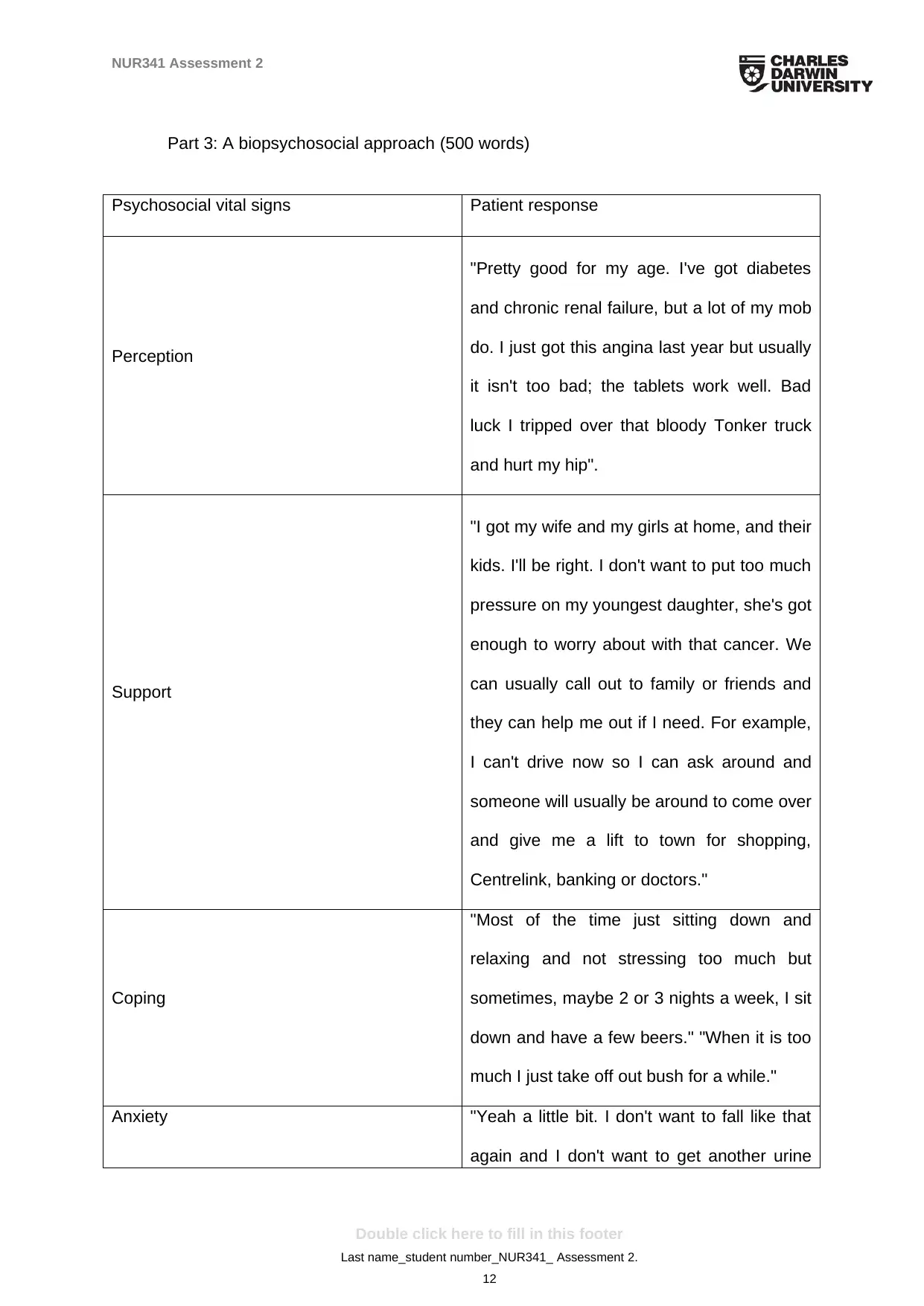
NUR341 Assessment 2
Part 3: A biopsychosocial approach (500 words)
Psychosocial vital signs Patient response
Perception
"Pretty good for my age. I've got diabetes
and chronic renal failure, but a lot of my mob
do. I just got this angina last year but usually
it isn't too bad; the tablets work well. Bad
luck I tripped over that bloody Tonker truck
and hurt my hip".
Support
"I got my wife and my girls at home, and their
kids. I'll be right. I don't want to put too much
pressure on my youngest daughter, she's got
enough to worry about with that cancer. We
can usually call out to family or friends and
they can help me out if I need. For example,
I can't drive now so I can ask around and
someone will usually be around to come over
and give me a lift to town for shopping,
Centrelink, banking or doctors."
Coping
"Most of the time just sitting down and
relaxing and not stressing too much but
sometimes, maybe 2 or 3 nights a week, I sit
down and have a few beers." "When it is too
much I just take off out bush for a while."
Anxiety "Yeah a little bit. I don't want to fall like that
again and I don't want to get another urine
Double click here to fill in this footer
Last name_student number_NUR341_ Assessment 2.
12
Part 3: A biopsychosocial approach (500 words)
Psychosocial vital signs Patient response
Perception
"Pretty good for my age. I've got diabetes
and chronic renal failure, but a lot of my mob
do. I just got this angina last year but usually
it isn't too bad; the tablets work well. Bad
luck I tripped over that bloody Tonker truck
and hurt my hip".
Support
"I got my wife and my girls at home, and their
kids. I'll be right. I don't want to put too much
pressure on my youngest daughter, she's got
enough to worry about with that cancer. We
can usually call out to family or friends and
they can help me out if I need. For example,
I can't drive now so I can ask around and
someone will usually be around to come over
and give me a lift to town for shopping,
Centrelink, banking or doctors."
Coping
"Most of the time just sitting down and
relaxing and not stressing too much but
sometimes, maybe 2 or 3 nights a week, I sit
down and have a few beers." "When it is too
much I just take off out bush for a while."
Anxiety "Yeah a little bit. I don't want to fall like that
again and I don't want to get another urine
Double click here to fill in this footer
Last name_student number_NUR341_ Assessment 2.
12
⊘ This is a preview!⊘
Do you want full access?
Subscribe today to unlock all pages.

Trusted by 1+ million students worldwide
1 out of 19
Related Documents
Your All-in-One AI-Powered Toolkit for Academic Success.
+13062052269
info@desklib.com
Available 24*7 on WhatsApp / Email
![[object Object]](/_next/static/media/star-bottom.7253800d.svg)
Unlock your academic potential
Copyright © 2020–2025 A2Z Services. All Rights Reserved. Developed and managed by ZUCOL.



